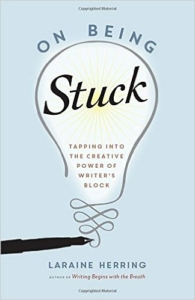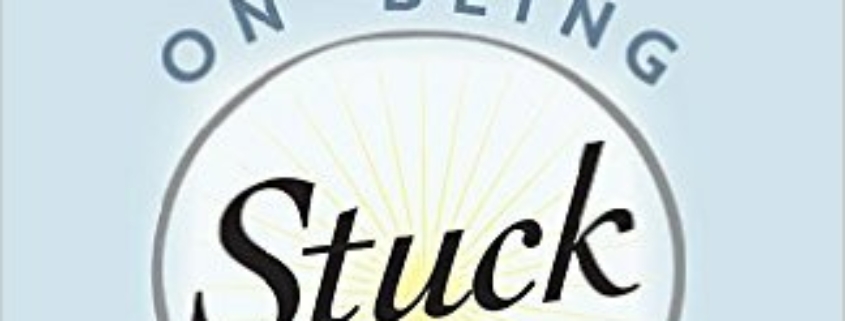Writers Read: On Being Stuck by Laraine Herring
 Writer’s block. We’ve all experienced it. Sometimes we force ourselves through it. Wait it out. Try a writing prompt, take a break for coffee or something to eat. And sometimes it’s stickier than that. Now, you can’t get a word down. You’re staring at the white page. Maybe a revision? Maybe you should start over—like, before you decided to be a writer. Maybe you should print out what you’ve got—and burn it. While many of us have learned to get through these blocks, or neglected their causes, ridiculed or criticized ourselves for having them at all, Laraine Herring’s On Being Stuck: Tapping into the Creative Power of Writer’s Block says that all artists get stuck. In fact, it’s natural and normal to do so, but it’s what we do once we are in them that matters. Herring proves that if we pay attention to and pursue the meaning behind our blocks, we can deepen our relationship with our writing and learn to harness our creativity in productive and empowering ways. Herring distinguishes between “writer-in-progress” blocks (a frustration within the writer) and “work-in-progress” blocks (a frustration within the work or craft) to teach readers how to tap into inevitable artistic barriers with deep inquiry, writing prompts and meditative practices.
Writer’s block. We’ve all experienced it. Sometimes we force ourselves through it. Wait it out. Try a writing prompt, take a break for coffee or something to eat. And sometimes it’s stickier than that. Now, you can’t get a word down. You’re staring at the white page. Maybe a revision? Maybe you should start over—like, before you decided to be a writer. Maybe you should print out what you’ve got—and burn it. While many of us have learned to get through these blocks, or neglected their causes, ridiculed or criticized ourselves for having them at all, Laraine Herring’s On Being Stuck: Tapping into the Creative Power of Writer’s Block says that all artists get stuck. In fact, it’s natural and normal to do so, but it’s what we do once we are in them that matters. Herring proves that if we pay attention to and pursue the meaning behind our blocks, we can deepen our relationship with our writing and learn to harness our creativity in productive and empowering ways. Herring distinguishes between “writer-in-progress” blocks (a frustration within the writer) and “work-in-progress” blocks (a frustration within the work or craft) to teach readers how to tap into inevitable artistic barriers with deep inquiry, writing prompts and meditative practices.
You’re staring at the white page. Maybe a revision? Maybe you should start over—like, before you decided to be a writer. Maybe you should print out what you’ve got—and burn it.
Any good craft book includes a few writing prompts, but what is most compelling about Herring’s guide to breaking through writer’s block is the emphasis on embodying our writing practice through breath and physical movement. She mentions in the preface that during her writing classes it’s her job to notice, “the slip of a warm tear from the lady in the corner or the unconscious clenching and unclenching of fists from the man.” Her attention to small physical manifestations of internal processes asserts that our bodies are connected directly to our writing, and if we believe this, then we can use our bodies as tools to access different parts of our minds when we are stuck. In one of her first deep inquiry practices, Herring asks the reader to go into a dialogue with one of their issues and recommends “doing these activities with a pen or pencil and paper rather than on a keyboard. Because the act of writing by hand is a form of doodling, physical lettering helps to release tension in your body and mind.” Just like trying a different hike or new yoga class to get out of a workout-rut, Herring’s suggestion to write by hand may help a writer get through a block simply by jogging different muscles than the ones we type with on a keyboard.
Herring also revisits two deep inquiry practices throughout On Being Stuck: the balancing breath and the writer’s mudra. These physical exercises are “quick and easy grounding tools… to help you return to your body and writing… quickly shift your energies and help you gain a different perspective on your current place in your work’s path.” For the balancing breath, she guides the reader into a motion that involves bringing the palms in and towards the nose and mouth on the inhale, and gently pressing them away on the exhale. The balancing breath encourages the writer to step away from their writing and slow down their thoughts to focus on simple physical actions, which anyone—no matter how stuck—can try.
 The writer’s mudra is a moving hand gesture similar to a prayer. Herring’s exercise requires designating one hand as the writer, one hand as their writing, bringing them together to create “the physical and symbolic meeting” of the writer and their writing, feeling the heat between the palms, rubbing them together to create energy, and then placing the hands on different energy sources of the body. This movement not only has symbolic resonance of a writer joining together with their writing, but asks the writer to re-engage with their body as a method to re-engage with their work. As writing often requires us to sit at a desk or computer for hours at a time and ignore our posture, these simple exercises bring awareness back to our bodies as a means of re-adjusting our perspective.
The writer’s mudra is a moving hand gesture similar to a prayer. Herring’s exercise requires designating one hand as the writer, one hand as their writing, bringing them together to create “the physical and symbolic meeting” of the writer and their writing, feeling the heat between the palms, rubbing them together to create energy, and then placing the hands on different energy sources of the body. This movement not only has symbolic resonance of a writer joining together with their writing, but asks the writer to re-engage with their body as a method to re-engage with their work. As writing often requires us to sit at a desk or computer for hours at a time and ignore our posture, these simple exercises bring awareness back to our bodies as a means of re-adjusting our perspective.
It’s no secret that going for a walk for fresh air and sunshine can aid the mind in gaining a clear perspective when we are blocked, but On Being Stuck promotes specific practices to embody our writing in a way that physically moving outside or stretching our legs doesn’t. Herring teaches us how to cultivate awareness and attention to our writing through our breath and skin. The process of writing can feel very abstract—especially when we are stuck sitting in a room staring at the ceiling, swimming in muddled thoughts, or void of ideas completely. Grounding ourselves in our bodies during periods of writer’s block is a quick way to bring our focus from the abstract to the concrete, and hopefully, to the next page.
 Katy Avila lives in Los Angeles, CA where she is an MFA candidate in fiction at Antioch University. Her obsession with Victorian pseudoscience, literature and culture, and interest in medical humanities have inspired her to look closely at the relationship between body and story, and how narratives attempt to embody (or disembody) modern experiences.
Katy Avila lives in Los Angeles, CA where she is an MFA candidate in fiction at Antioch University. Her obsession with Victorian pseudoscience, literature and culture, and interest in medical humanities have inspired her to look closely at the relationship between body and story, and how narratives attempt to embody (or disembody) modern experiences.





